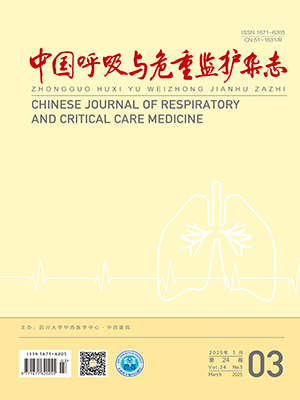| 1. |
horax, 2006, 61: 621-626.
|
| 2. |
Belperio JA, Keane MP, Lynch JP, et al. The role of cytokines during the pathogenesis of ventilator-associated and ventilator-induced lung injury. Semin Respir Crit Care Med, 2006,27: 350-364.
|
| 3. |
Fudala R, Krupa A, Stankowska D, et al. Anti-interleukin-8 autoantibody: interleukin-8 immune complexes in acute lung injury /acute respiratory distress syndrome. Clin Sci ( Lond) , 2008, 114:403-412.
|
| 4. |
Imai Y, Kuba K, Penninger JM. The discovery of angiotensinconverting enzyme 2 and its role in acute lung injury in mice. Exp Physiol, 2008, 93: 543-548.
|
| 5. |
Medford AR,Millar AB. Vascular endothelial growth factor ( VEGF)in acute lung injury ( ALI) and acute respiratory distress syndrome( ARDS) : paradox or paradigm? T.
|
| 6. |
Schultz MJ, Haitsma JJ, Zhang H, et al. Pulmonary coagulopathy as a new target in therapeutic studies of acute lung injury or pneumonia--a review. Crit Care Med, 2006, 34: 871-877.
|
| 7. |
Villar J, Flores C, Mendez-Alvarez S. Genetic susceptibility to acute lung injury. Crit Care Med, 2003, 31: S272-275.
|
| 8. |
Meyer NJ, Garcia JG. Wading into the genomic pool to unravel acute lung injury genetics. Proc Am Thorac Soc, 2007, 4: 69-76.
|
| 9. |
Lam E, dos Santos CC. Advances in molecular acute lung injury /acute respiratory distress syndrome and ventilator-induced lung injury: the role of genomics, roteomics, bioinformatics and translational biology. Curr Opin Crit Care, 2008, 14: 3-10.
|
| 10. |
Cho HY, Jedlicka AE, Reddy SP, et al. Linkage analysis of susceptibility to hyperoxia. Nrf2 is a candidate gene. Am J Respir Cell Mol Biol, 2002, 26: 42-51.
|
| 11. |
Marzec JM, Christie JD, Reddy SP, et al. Functional polymorphisms in the transcription factor NRF2 in humans increase the risk of acute lung injury. FASEB J, 2007, 21: 2237-2246.
|
| 12. |
Marshall RP, Webb S, Bellingan GJ, et al. Angiotensin converting enzyme insertion/ deletion polymorphism is associated with susceptibility and outcome in acute respiratory distress syndrome.Am J Respir Crit Care Med, 2002, 166: 646-650.
|
| 13. |
Villar J, Flores C, Perez-Mendez L, et al. Angiotensin-converting enzyme insertion/deletion polymorphism is not associated with susceptibility and outcome in sepsis and acute respiratory distress syndrome. Intensive Care Med, 2008, 34: 488-495.
|
| 14. |
Floros J, Veletza SV, Kotikalapudi P, et al. Dinucleotide repeats in the human surfactant protein-B gene and respiratory-distress syndrome. Biochem J, 1995, 305 ( Pt 2) : 583-590.
|
| 15. |
Lin Z, Pearson C, Chinchilli V, et al. Polymorphisms of human SPA,SP-B, and SP-D genes: association of SP-B Thr131Ile with ARDS. Clin Genet, 2000, 58: 181-191.
|
| 16. |
Wang G, Christensen ND, Wigdahl B, et al. Differences in N-linked glycosylation between human surfactant protein-B variants of the C or T allele at the single-nucleotide polymorphism at position 1580 :implications for disease. Biochem J, 2003, 369: 179-184.
|
| 17. |
Wurfel MM, Gordon AC, Holden TD, et al. Toll-like receptor 1 polymorphisms affect innate immune responses and outcomes in sepsis. Am J Respir Crit Care Med, 2008, 178: 710-720.
|
| 18. |
Gao L, Grant A, Halder I, et al. Novel polymorphisms in the myosin light chain kinase gene confer risk for acute lung injury. Am J Respir Cell Mol Biol, 2006, 34: 487-495.
|
| 19. |
Ye SQ, Simon BA, Maloney JP, et al. Pre-B-cell colony-enhancing factor as a potential novel biomarker in acute lung injury. Am J Respir Crit Care Med, 2005, 171: 361-370.
|
| 20. |
Nonas SA, Moreno-Vinasco L, Ma SF, et al. Use of consomic rats for genomic insights into ventilator-associated lung injury. AmJPhysiol Lung Cell Mol Physiol, 2007, 293: L292-302.
|
| 21. |
dos Santos CC, Okutani D, Hu P, et al. Differential gene profiling in acute lung injury identifies injury-specific gene expression. Crit Care Med, 2008, 36: 855-865.
|
| 22. |
Kamp R, Sun X, Garcia JG. Making genomics functional:deciphering the genetics of acute lung injury. Proc Am Thorac Soc,2008, 5: 348-353.
|
| 23. |
Wang X, Dalkic E, Wu M, et al. Gene module level analysis:identification to networks and dynamics. Curr Opin Biotechnol,2008, 19: 482-491.
|
| 24. |
Oti M, Brunner HG. The modular nature of genetic diseases. ClinGenet, 2007 , 71 : 1 -11.
|
| 25. |
高芸. 基于基因本体论的生物信息个人数据库平台. 生命科学研究, 2004, 8: 65-70.
|
| 26. |
Gharib SA, Liles WC, Matute-Bello G, et al. Computational identification of key biological modules and transcription factors in acute lung injury. Am J Respir Crit Care Med, 2006, 173: 653-658.
|
| 27. |
Simon BA, Easley RB, Grigoryev DN, et al. Microarray analysis of regional cellular responses to local mechanical stress in acute lung injury. AmJ Physiol Lung Cell Mol Physiol, 2006, 291: L851-861.
|
| 28. |
Kamp R, Sun X, Garcia JG. Making genomics functional:deciphering the genetics of acute lung injury. Proc Am Thorac Soc ,2008, 5: 348-353.
|




